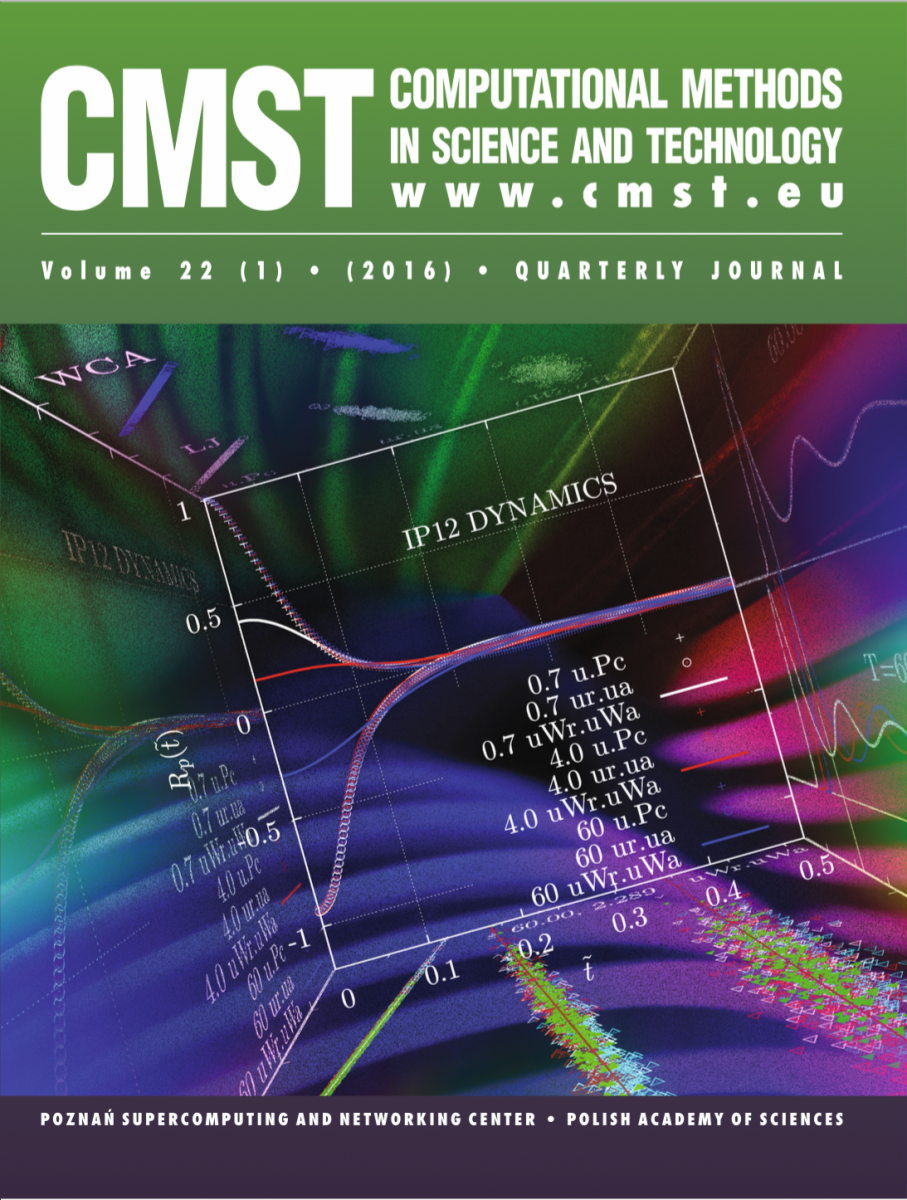Limitations of Applicability of the Green-Kubo Approach for Calculating the Thermal Conductivity of a Confined Liquid in Computer Simulations
Hyżorek Krzysztof 1, Tretiakov Konstantin V. 1,2*
1 Institute of Molecular Physics
Polish Academy of Sciences, Smoluchowskiego 17, 60-179 Poznań, Poland2 President St. Wojciechowski PWSZ in Kalisz
Nowy Swiat 4, 62-800 Kalisz, Poland
*E-mail: kvt@ifmpan.poznan.pl
Received:
Received: 18 November 2016; revised: 24 November 2016; accepted: 25 November 2016; published online: 06 December 2016
DOI: 10.12921/cmst.2016.0000054
Abstract:
Thermal conductivity (λ) of the Lennard-Jones liquid in cylindrical nanochannels has been determined using the Green-Kubo (GK) approach in equilibrium Molecular Dynamics simulations. Good convergence of λ(τ ) has been observed along the nanochannel’s axis where the periodic boundary conditions are applied. However, it has been found that the
estimation of limiting value of λ(τ ) in the transverse direction, where walls confine the liquid, is ambiguous.
Key words:
Molecular Dynamics simulations, nanochannels, simple liquids, the Green-Kubo method, thermal conductivity
References:
[1] M. Bacon, S.J. Bradley, T. Nann, Graphene Quantum Dots,
Part. Part. Syst. Char. 31(4), 415 (2014).
[2] R. Kubo, J. Phys. Soc. Japan 12 (1957).
[3] R. Zwanzig, Time-Correlation Functions and Transport Coef-
ficients in Statistical Mechanics, Annu. Rev. Phys. Chem., 16
(1965).
[4] J. Petravic, P. Harrowell, Linear response theory for thermal
conductivity and viscosity in therms of boundary fluctuations,
Phys. Rew. E 71(061201) (2005).
[5] J. Petravic, P. Harrowell, An equilibrium calculation of ther-
mal transport coefficients between two planes of arbitrary sep-
aration in a condensed phase, J. Chem. Phys. 124, 0445112
(2006).
[6] J. Petravic, P. Harrowell, Equilibrium calculations of viscosity
and thermal conductivity across a solid-liquid interface using
boundary fluctuations, J. Chem. Phys. 128(194710) (2008).
[7] A.E. Giannakopoulos, F. Sofos, T.E. Karakasidis, A. Li-
akopoulos, Unified description of size effects of transport
properties of liquids flowing in nanochannels, Int. J. Heat
Mass Tran. (55), 5087-5092 (2012).
[8] M. Frank, D. Drikakis, N. Asproulis, Thermal conductivity
of nanofluid in nanochannels, Microfluid. Nanofluid. 19(5),
1011-1017 (2015).
[9] K. Hyżorek, K.V. Tretiakov, Thermal conductivity of liquid
argon in nanochannels from molecular dynamics simulations,
J. Chem. Phys. 144, 194507 (2016).
[10] M. P. Allen, D. J. Tildesley, Computer Simulation of Liquids,
J. W. Arrowsmith Ltd., Bristol, UK, 1987.
[11] J.P. Hansen, I.R. McDonald, Theory of Simple Liquids, Aca-
demic, New York, 2005.
[12] J. G. Kirkwood, The Statistical Mechanical Theory of Trans-
port Processes I. General Theory, J. Chem. Phys. 14 (1946).
[13] D. Heyes, Transport-Coefficients of Lennard-Jones Fluids – A
Molecular-Dynamics and Effective-Hard-Sphere Treatment,
Phys. Rev. B 37, 5677 (1988).
[14] K.V. Tretiakov, S. Scandolo, Thermal conductivity of solid
argon for molecular dynamics simulations, J. Chem. Phys.
120(8), 3765-3769 (2004).
Thermal conductivity (λ) of the Lennard-Jones liquid in cylindrical nanochannels has been determined using the Green-Kubo (GK) approach in equilibrium Molecular Dynamics simulations. Good convergence of λ(τ ) has been observed along the nanochannel’s axis where the periodic boundary conditions are applied. However, it has been found that the
estimation of limiting value of λ(τ ) in the transverse direction, where walls confine the liquid, is ambiguous.
Key words:
Molecular Dynamics simulations, nanochannels, simple liquids, the Green-Kubo method, thermal conductivity
References:
[1] M. Bacon, S.J. Bradley, T. Nann, Graphene Quantum Dots,
Part. Part. Syst. Char. 31(4), 415 (2014).
[2] R. Kubo, J. Phys. Soc. Japan 12 (1957).
[3] R. Zwanzig, Time-Correlation Functions and Transport Coef-
ficients in Statistical Mechanics, Annu. Rev. Phys. Chem., 16
(1965).
[4] J. Petravic, P. Harrowell, Linear response theory for thermal
conductivity and viscosity in therms of boundary fluctuations,
Phys. Rew. E 71(061201) (2005).
[5] J. Petravic, P. Harrowell, An equilibrium calculation of ther-
mal transport coefficients between two planes of arbitrary sep-
aration in a condensed phase, J. Chem. Phys. 124, 0445112
(2006).
[6] J. Petravic, P. Harrowell, Equilibrium calculations of viscosity
and thermal conductivity across a solid-liquid interface using
boundary fluctuations, J. Chem. Phys. 128(194710) (2008).
[7] A.E. Giannakopoulos, F. Sofos, T.E. Karakasidis, A. Li-
akopoulos, Unified description of size effects of transport
properties of liquids flowing in nanochannels, Int. J. Heat
Mass Tran. (55), 5087-5092 (2012).
[8] M. Frank, D. Drikakis, N. Asproulis, Thermal conductivity
of nanofluid in nanochannels, Microfluid. Nanofluid. 19(5),
1011-1017 (2015).
[9] K. Hyżorek, K.V. Tretiakov, Thermal conductivity of liquid
argon in nanochannels from molecular dynamics simulations,
J. Chem. Phys. 144, 194507 (2016).
[10] M. P. Allen, D. J. Tildesley, Computer Simulation of Liquids,
J. W. Arrowsmith Ltd., Bristol, UK, 1987.
[11] J.P. Hansen, I.R. McDonald, Theory of Simple Liquids, Aca-
demic, New York, 2005.
[12] J. G. Kirkwood, The Statistical Mechanical Theory of Trans-
port Processes I. General Theory, J. Chem. Phys. 14 (1946).
[13] D. Heyes, Transport-Coefficients of Lennard-Jones Fluids – A
Molecular-Dynamics and Effective-Hard-Sphere Treatment,
Phys. Rev. B 37, 5677 (1988).
[14] K.V. Tretiakov, S. Scandolo, Thermal conductivity of solid
argon for molecular dynamics simulations, J. Chem. Phys.
120(8), 3765-3769 (2004).

